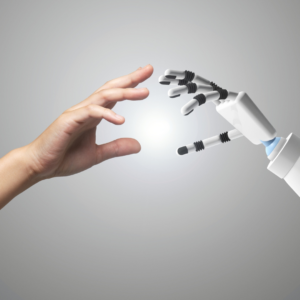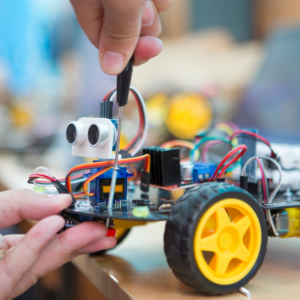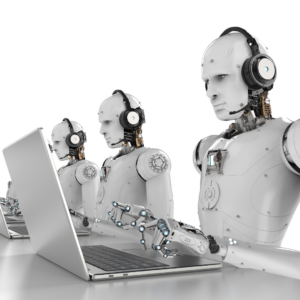Emerging Disruptors in Robotics
Delivered – Virtually
November 11, 2025
Welcome to the Emerging Disruptors in Robotics Conference. Join investors, dealmakers and representatives from the robotics industries. Listen to CEOs of some of the most dynamic robotics technology companies discuss their products, services and innovations. Don’t miss this opportunity to learn about groundbreaking developments shaping the future of robotics. Attend virtually on November 11, 2025.
The global robotics technology market was valued at $94.5 billion in 2024 and is projected to grow to $108.4 billion in 2025, with a compound annual growth rate of 14.7%.
Key drivers for the growth of the robotics industry include:
 Increasing Demand for Automation: Robotics is essential for improving efficiency, reducing costs, and addressing labor shortages across industries. Automation is rapidly expanding in manufacturing, logistics, healthcare, and e-commerce operations.
Increasing Demand for Automation: Robotics is essential for improving efficiency, reducing costs, and addressing labor shortages across industries. Automation is rapidly expanding in manufacturing, logistics, healthcare, and e-commerce operations.- Advancements in Technology:
- Artificial Intelligence (AI): AI-powered robots can learn, adapt, and operate autonomously, improving productivity across sectors.
- Sensor Technologies: Advanced sensors boost safety, accuracy, and functionality in robotics.
- Internet of Things (IoT): IoT connectivity enables real-time data sharing between systems, enhancing operational efficiency.
- Collaborative Robots (Cobots): Cobots work safely alongside humans and are being widely adopted in healthcare, manufacturing, and retail.
- Cost Efficiency: Falling costs are making robotics more accessible to small and medium-sized enterprises (SMEs), delivering fast ROI through higher productivity and lower operational expenses.
- Labor Shortages: Robotics provides a solution for industries facing labor deficits, especially in manufacturing and logistics.
- Government Support and Investment: National governments are offering funding, tax incentives, and supportive policies to accelerate automation.
- Environmental Sustainability: Robotics contributes to sustainability through improved energy efficiency, precise operations that reduce waste, and eco-conscious production.
- Emerging Applications: Robotics is gaining traction in new areas such as:
- Healthcare (e.g., robotic-assisted surgeries)
- Agriculture (e.g., automated harvesting)
Transportation (e.g., autonomous vehicles)
Here are specific examples of new robotics technologies:
 Artificial Intelligence (AI) and Machine Learning: AI integration enables robots to interpret complex data, make real-time decisions, and perform predictive maintenance. Machine learning models, including reinforcement learning, allow robots to learn from trial and error, adapt to dynamic environments, and refine their performance over time. Enhanced computer vision systems powered by AI enable robots to recognize objects, analyze scenes, and navigate environments with precision.
Artificial Intelligence (AI) and Machine Learning: AI integration enables robots to interpret complex data, make real-time decisions, and perform predictive maintenance. Machine learning models, including reinforcement learning, allow robots to learn from trial and error, adapt to dynamic environments, and refine their performance over time. Enhanced computer vision systems powered by AI enable robots to recognize objects, analyze scenes, and navigate environments with precision.
Mobile Manipulators: These robots combine mobile platforms with manipulator arms, enabling them to transport objects, perform repetitive tasks like assembly, and operate efficiently in dynamic industrial environments.
Digital Twin Technology: Digital twins create virtual replicas of robotic systems for real-time analysis and optimization. This technology allows simulated testing, performance refinement, and predictive maintenance without physical risks.
Humanoid Robots: Humanoids are advancing with improved mobility and dexterity, enabling them to navigate complex environments and perform versatile tasks such as healthcare assistance and hazardous area inspections.
Robotic Exoskeletons: Exoskeletons enhance human strength, endurance, and mobility, proving valuable in sectors like manufacturing and healthcare.
Soft Robotics Soft robotics focuses on delicate tasks using flexible materials. These robots are ideal for handling fragile items in industries like food processing, electronics manufacturing, and healthcare.
Autonomous Navigation: Technologies like simultaneous localization and mapping (SLAM) enable robots to navigate complex environments autonomously without predefined maps. This is particularly useful for search-and-rescue operations and industrial automation.
Sustainable Robotics: Eco-friendly designs include recyclable materials, energy-efficient systems, and green manufacturing practices to reduce environmental impact.
Swarm Robotics: Swarm robotics involves multiple robots working collaboratively to complete tasks such as disaster response or hazardous environment navigation. These systems leverage collective intelligence for efficiency.
 Venture capital investments in robotics companies rebounded in 2024. Venture capital invested in robotics companies reached an estimated $7.5 billion in 2024, up from $6.4 billion in 2023.
Venture capital investments in robotics companies rebounded in 2024. Venture capital invested in robotics companies reached an estimated $7.5 billion in 2024, up from $6.4 billion in 2023.
Below are some of the robotics companies that received significant venture funding in early 2025:
| Company | Amount Raised | Investors |
| Dexterity | $95 million | Lightspeed Venture Partners, Sumitomo |
|
GreyOrange
|
$135 million | Anthelion Capital, Mithril Capital, Blume Ventures |
|
Goat Robotics
|
$311,000 | Campus Angels Network, Native Lead Angels |
|
Corvus Robotics
|
$23.1 million | Undisclosed |
|
Elroy Air
|
$48 million | Undisclosed |
|
Agility Robotics
|
$400 million | Undisclosed |
| CynLr | $10 million | Undisclosed |
Below are highlights of recent acquisitions in the robotics industry:
| Acquirer | Target | Description of Transactions |
Date of Transaction
|
| Zebra Technologies | Photoneo |
Photoneo was acquired to enhance Zebra’s high-precision robotic arm solutions.
|
December 2024 |
| Symbotic | Walmart’s Advanced Systems & Robotics |
Deal includes a $520M commercial agreement to deploy AI-driven logistics robots across 400 Walmart stores.
|
January 2025 |
| Nauticus Robotics | SeaTrepid International |
Merges Nauticus’ autonomous subsea robots with SeaTrepid’s offshore robotic services.
|
March 2025 |
| Kraken Robotics | 3D at Depth |
Expands Kraken’s underwater robotics capabilities with lidar and subsea imaging tech.
|
March 2025 |
| LG Electronics | Bear Robotics |
Integrates Bear’s autonomous service robots into LG’s commercial robotics division.
|
2024 |
| CNH Industrial | Advanced Farm |
Adds robotic apple-picking technology to CNH’s agricultural automation portfolio.
|
2024 |
Management teams will present insights into their:
- Product offerings (current and in development)
- Addressable markets and customer segments
- R&D initiatives and proprietary technology
- Business models, licensing, and collaborations
- Distribution, manufacturing, and expansion strategies
Milestones and exit strategies.
Please check back for the agenda of presenting companies. If you would like to nominate a company to present, please contact Tabitha Owuor at tabitha@davosinthedesert.us.
Registration is free for members of Davos in the Desert. The registration price for non-members is just $10. Registration is for one attendee. No refunds.


